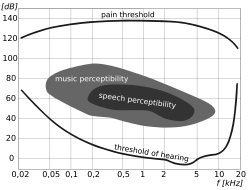Hearing threshold
The hearing threshold (also quiet hearing threshold ) is the sound pressure or sound pressure level at which the human ear can just barely perceive tones or noises.
The hearing threshold forms the lower limit of the hearing area (also known as the hearing area or hearing field) - the upper limit is called the acoustic pain threshold .

Note: The graphic shows the physical sound pressure level in dB SPL . In the case of individual audiograms , a weighted sound pressure level is usually shown at which the generally applicable hearing threshold forms the zero line.
values
The hearing threshold depends on the frequency .
- At 2 kHz it is at a sound pressure level of zero decibels (dB), corresponding to 20 µPa.
- Both at lower frequencies and at very high frequencies, the hearing threshold is shifted to higher levels. Both a low sine tone of 30 Hz and a high one of 15 kHz can only be perceived by normal hearing people from a sound pressure level of around 60 dB.
- The human ear is most sensitive to frequencies between 3500 and 4000 Hz. In this frequency range it can register sound pressure levels of down to minus 5 dB, which corresponds to a sound pressure of just 1.125 · 10 −5 Pascal (11.25 µPa).
- For the audibility threshold of a sinusoidal tone of 1000 Hz, a sound pressure of 2 · 10 −5 Pascal (20 μ Pa) was set as a reference value for the absolute sound pressure level (an average value from measurements on many individuals). Later it turned out that this value was set a little too low for 1000 Hz and applies approximately to 2000 Hz. Nevertheless, the original value was retained.
The highest frequency that can be perceived depends on age and state of health. With increasing age, the hearing threshold increases, especially at higher frequencies ( presbycusis ).
Measurement
The hearing threshold is determined with sine tones , in tone audiometry with sine tones of fixed frequencies (usually 250, 500, 1000, 2000, 3000, 4000, 6000 and 8000 Hz).
With Békésy tracking , the audio frequency changes slowly and continuously over the entire frequency range. The tones are presented through precisely calibrated headphones; Alternatively, the binaural hearing threshold can be determined with a frontally positioned sound source .
The hearing threshold can be determined using the so-called input method or the method with increasing levels. With the input method, the hearing threshold is determined by averaging the results of measurements with increasing and decreasing levels, with the method with increasing levels the test tone level is increased from the inaudible range until it becomes audible. As a rule, the rising level method is used.
The hearing threshold for people with normal hearing is used as the basis for assessing hearing loss, as is specified in DIN 45630 Part 2 and ISO 226: 2003 as part of the “normal curves for the same volume level”. If hearing is impaired, the individual hearing threshold deviates from the normal curve. The tone audiogram is the basis for diagnosing hearing impairment or hearing impairment .
swell
- ↑ ISO 8253-1: 1989, Acoustics: Audiometric test methods, Part 1: Basic pure tone air and bone conduction threshold audiometry.
